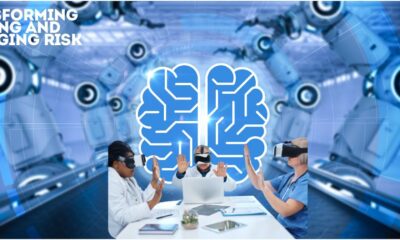Innovations
The Rise of Generative AI: A New Era of Creativity and Innovation

Generative AI, a subfield of artificial intelligence, has witnessed an unprecedented surge in development and deployment over the past few years. Models like OpenAI’s GPT-4 and DALL-E are at the forefront of this revolution, offering capabilities that extend far beyond traditional AI applications. These tools are not only creating content that rivals human creativity but are also transforming industries by assisting in research, automating tasks, and generating art. However, this rapid advancement has sparked both excitement and concern, particularly regarding the implications for creativity, employment, and the ethical use of AI in society.
Understanding Generative AI: The Technology Behind the Revolution
1. What is Generative AI?
Generative AI refers to systems capable of generating new content—whether text, images, music, or even video—based on the data they have been trained on. Unlike traditional AI models, which typically analyze or classify data, generative AI can create novel outputs, often mimicking the complexity and nuance of human-generated content.
2. Key Technologies: GPT-4 and DALL-E
- GPT-4: OpenAI’s GPT-4, an iteration of the Generative Pre-trained Transformer series, represents a significant leap in natural language processing. Capable of understanding and generating human-like text, GPT-4 can produce everything from simple sentences to complex essays, making it a powerful tool for applications in content creation, customer service, and more.
- DALL-E: DALL-E, another innovation from OpenAI, is a neural network that generates images from textual descriptions. This model can create visually coherent images that range from realistic to fantastical, providing a new medium for artists, designers, and content creators.
The Surge in Development and Deployment Across Industries
1. Widespread Adoption: Transforming Multiple Sectors
The rapid advancement of generative AI models has led to their widespread adoption across a variety of industries. These models are being used to enhance productivity, drive innovation, and create new opportunities.
- Creative Industries: Generative AI is reshaping the creative industries by providing tools that assist in the creation of artwork, music, and literature. DALL-E, for instance, is being used by graphic designers to generate unique visual content that would take hours to produce manually. According to a report by Adobe, over 30% of designers have started using AI tools like DALL-E to enhance their workflows, allowing them to focus more on the conceptual aspects of their work rather than execution.
- Healthcare: In healthcare, generative AI models like GPT-4 are being used to draft medical reports, summarize patient data, and even assist in the research and development of new drugs. The use of AI in healthcare is projected to grow significantly, with the global AI healthcare market expected to reach $45.2 billion by 2026, according to a report by MarketsandMarkets. Generative AI, in particular, is being lauded for its ability to process large datasets and generate insights that can lead to better patient outcomes.
- Education: The education sector is also benefiting from generative AI, where these models are used to create personalized learning experiences, automate grading, and assist in academic research. A study by the World Economic Forum highlighted that AI-powered tools could personalize education for millions of students, helping them learn at their own pace and style. GPT-4, for example, is being used to generate tailored content for students, ranging from simple explanations to complex problem-solving exercises.
2. Emerging Applications: Beyond Traditional Use Cases
Beyond the more obvious applications, generative AI is finding its way into less traditional areas, creating new possibilities and challenging existing paradigms.
- Legal Industry: In the legal industry, generative AI is being used to draft legal documents, analyze case law, and even predict case outcomes. Law firms are leveraging tools like GPT-4 to streamline the document creation process, saving significant time and resources. According to a survey by the American Bar Association, nearly 20% of law firms have started integrating AI into their workflows, with generative AI playing a critical role in legal research and document automation.
- Customer Service: AI-driven chatbots that utilize models like GPT-4 are becoming increasingly popular in customer service. These bots can handle a wide range of inquiries, providing instant responses and resolving issues without the need for human intervention. According to Gartner, by 2025, AI will power 95% of customer interactions, with generative AI models significantly enhancing the efficiency and effectiveness of customer service operations.
- Manufacturing and Design: In manufacturing, generative AI is being used to optimize design processes and create new products. For example, AI can generate multiple design iterations based on specific parameters, allowing engineers to explore a wider range of possibilities in less time. This approach is particularly useful in industries like automotive and aerospace, where design innovation is critical to maintaining a competitive edge.
The Ethical and Societal Implications of Generative AI
1. Creativity and Authorship: Redefining the Boundaries
One of the most significant ethical debates surrounding generative AI is its impact on creativity and authorship. As AI-generated content becomes more prevalent, questions arise about the nature of creativity and who should be credited for the work produced by these models.
- Intellectual Property Concerns: The rise of generative AI has led to complex legal questions regarding intellectual property (IP). For instance, if a piece of art is generated by DALL-E based on a prompt provided by a user, who owns the rights to that artwork? Is it the developer of the AI, the user who provided the prompt, or should the AI itself be recognized as the creator? These questions are not merely theoretical; they have significant implications for industries where IP rights are crucial.
- Impact on Artists and Creators: Many artists and creators express concern that AI tools like DALL-E could undermine their work by flooding the market with AI-generated content that competes directly with human-created works. A survey conducted by the American Society of Media Photographers (ASMP) found that 60% of photographers and visual artists are worried about the potential for AI to devalue their work by enabling the mass production of images that mimic their style.
2. Employment and the Future of Work: Opportunities and Challenges
The deployment of generative AI across various industries is also raising concerns about its impact on employment. While AI has the potential to create new job opportunities, it also threatens to displace workers in certain sectors.
- Automation of White-Collar Jobs: Generative AI is particularly disruptive to white-collar jobs that involve cognitive tasks, such as writing, designing, and data analysis. For example, GPT-4 is capable of generating reports, drafting emails, and even creating marketing copy—tasks traditionally performed by human workers. According to a report by McKinsey & Company, up to 45% of work activities could be automated by AI, with generative AI playing a significant role in this transformation.
- Reskilling and Education: As AI continues to evolve, there is an increasing need for reskilling programs to help workers adapt to the changing job market. Governments and educational institutions are beginning to recognize the importance of AI literacy, data science, and other skills that complement AI technologies. A report by the World Economic Forum estimates that by 2025, 50% of all employees will need reskilling as AI and automation alter the nature of work.
3. Ethical AI Development: Ensuring Fairness and Transparency
Ensuring that AI is developed and deployed ethically is a major concern for researchers, policymakers, and industry leaders. The rapid advancement of generative AI has outpaced the development of regulatory frameworks, leading to a range of ethical dilemmas.
- Bias and Fairness: One of the key challenges in AI development is ensuring that models are free from bias. Generative AI models are trained on large datasets that may contain biases, which can be reflected in their outputs. For example, GPT-4 might generate biased or stereotypical content, raising concerns about fairness and discrimination. A study by MIT Technology Review found that many AI models, including generative ones, still struggle with bias, particularly in areas like language processing and image generation.
- Transparency and Accountability: There is a growing demand for transparency in how AI models are developed and used. This includes the need for explainable AI systems that allow users to understand how decisions are made and to hold developers accountable for the consequences of those decisions. In response, some AI developers are working on creating more transparent models and establishing ethical guidelines for AI use.
The Future of Generative AI: Opportunities and Challenges Ahead
1. Continued Innovation: Pushing the Boundaries
The field of generative AI is still in its early stages, and continued innovation is expected to drive new applications and capabilities. Researchers are exploring ways to improve the performance of these models and extend their applicability to new domains.
- Multi-Modal Models: One area of active research is the development of multi-modal models that can process and generate different types of content simultaneously, such as text, images, and video. This could lead to even more powerful AI tools that can create complex, multi-faceted outputs from simple inputs. According to a report by Stanford University, multi-modal AI represents the next frontier in AI development, with the potential to revolutionize industries ranging from entertainment to healthcare.
- AI in Scientific Research: Generative AI is poised to play a major role in scientific research, from generating new hypotheses to simulating complex phenomena. This could accelerate the pace of discovery in fields like physics, biology, and chemistry. A study published in the journal Nature highlighted the potential of generative AI to assist researchers in designing experiments, analyzing data, and even writing research papers.
2. Regulatory and Governance Challenges: Navigating the Ethical Landscape
As generative AI becomes more widespread, the need for effective regulation and governance will become increasingly urgent. Policymakers and industry leaders must work together to develop frameworks that ensure the safe and ethical use of AI.
- Global Cooperation: Given the global nature of AI development, international cooperation will be essential to create standards and regulations that ensure the responsible use of generative AI. The European Union has already taken steps in this direction with its proposed AI Act, which seeks to establish comprehensive rules for AI development and deployment. According to a report by the European Commission, the AI Act aims to ensure that AI technologies are used in a way that respects fundamental rights and values.
- Balancing Innovation and Ethics: Policymakers will need to strike a balance between fostering innovation and protecting the public from the potential risks of AI. This includes creating frameworks that promote ethical AI development while allowing for continued technological progress. The challenge will be to ensure that regulation does not stifle innovation while still addressing the ethical and societal concerns associated with AI.
3. Public Perception and Acceptance: Building Trust in AI
The future of generative AI will also depend on public perception and acceptance. As AI tools become more integrated into daily life, it is crucial to address public concerns and build trust in these technologies.
- Education and Awareness: Increasing public understanding of AI and its capabilities will be key to ensuring that these technologies are accepted and used responsibly. This includes efforts to educate the public about the benefits and risks of AI, as well as initiatives to promote AI literacy. According to a survey by Pew Research Center, a significant portion of the public remains skeptical about AI, particularly regarding its impact on jobs and privacy.
- Addressing Fears and Misconceptions: Efforts to address fears and misconceptions about AI, such as concerns about job displacement or the loss of human creativity, will be important in shaping public attitudes toward generative AI. By engaging with the public and providing clear, accurate information, stakeholders can help build a more informed and confident society.
Conclusion
Generative AI represents a significant leap forward in artificial intelligence, with the potential to transform industries and redefine the boundaries of creativity and productivity. However, as with any powerful technology, it comes with a range of ethical and societal challenges that must be carefully managed. By fostering responsible innovation and developing robust ethical frameworks, society can harness the benefits of generative AI while mitigating its risks. The future of generative AI will be shaped not only by technological advancements but also by the decisions we make today regarding its development and deployment.
-

 Food19 hours ago
Food19 hours agoHow to Lose Weight Fast: The Best Drink Recipes for Rapid Results
-

 News11 hours ago
News11 hours agoUnfiltered: Behind the Headlines with Page Six
-

 Education19 hours ago
Education19 hours agoUnlocking the ASUS Student Discount on Reddit: A Comprehensive Guide
-

 Banking16 hours ago
Banking16 hours agoUnlock Your Financial Potential with SoFi High-Yield Savings


































